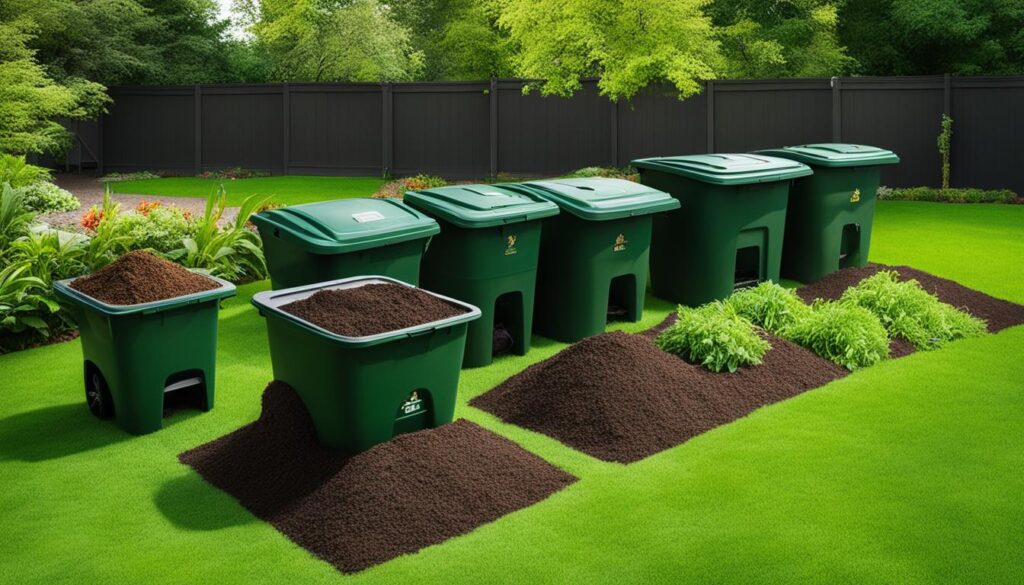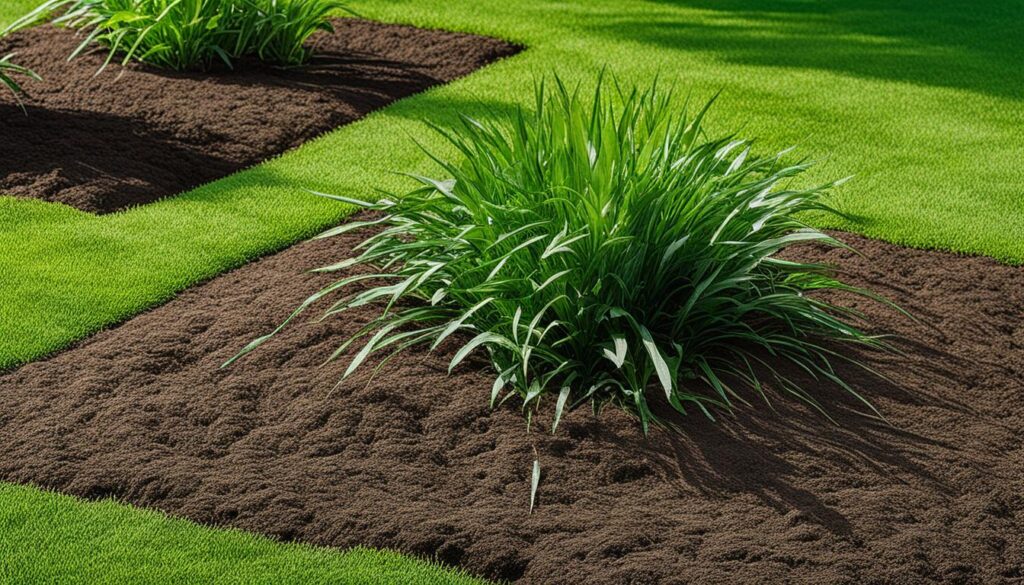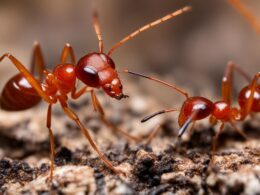Welcome to our comprehensive guide on grass recycling. In this article, we will show you how to efficiently compost your grass clippings, turning them into valuable nutrients for your lawn. By recycling your grass clippings, you can reduce waste, improve soil health, and contribute to a greener environment.
Did you know that the average lawn generates about 1,500 pounds of grass clippings per year? That’s a significant amount of waste that can be put to better use. Contrary to popular belief, grass clippings do not cause thatch and are best recycled by letting them fall back to the turf or using them as mulch. By doing this, you not only save time and reduce the need for fertilizer but also keep grass clippings out of landfills.
Grass clippings contain essential nutrients like nitrogen, phosphorus, and potassium, making them a valuable resource for your lawn. Through composting, you can harness these nutrients and create a nutrient-rich soil amendment that will benefit your plants. Composting grass clippings is not only easy but also an effective way to recycle them.
In the following sections, we will explore the benefits of recycling grass clippings, provide tips for proper recycling, and discuss alternative disposal options. Whether you choose to compost or use grass clippings as mulch, we have you covered. Together, we can make a positive impact on both the health of our lawns and the environment.
The Benefits of Recycling Grass Clippings
Recycling grass clippings offers numerous benefits for both your lawn and the environment. By leaving clippings on the lawn or using them as mulch, you can reduce waste by up to 10% and send fewer plastic bags to the landfill.
Grass clippings are about 85-90% water, so they shrink by about the same amount when left on the turf to dry. Once clippings settle, they decompose quickly because they are mostly soft tissue. This decomposition process releases nutrients back into the soil, providing natural fertilization for your lawn.
Additionally, recycling grass clippings can help improve soil health by adding organic matter and increasing microbial activity. When clippings decompose, they enrich the soil with beneficial nutrients and enhance its overall structure. The result is a healthier, more vibrant lawn that requires fewer external inputs like synthetic fertilizers.
By recycling grass clippings, you not only save time and effort by avoiding bagging and disposal, but you also contribute to a more sustainable approach to lawn care. So, embrace the benefits of recycling grass clippings and let nature work its magic in reducing waste, providing nutrients, and improving soil health in your yard.
Tips for Recycling Grass Clippings
To effectively recycle grass clippings, follow these essential tips:
Mow at the Proper Height
When mowing your lawn, ensure you cut the grass to the appropriate height, avoiding the removal of more than a third of its length at once. This practice helps maintain a healthy lawn and prevents the clippings from smothering the grass.
Keep Mower Blades Sharp
Sharp mower blades are crucial for efficient cutting and chopping of grass clippings. Regularly check and sharpen your mower blades to ensure optimal performance. Dull blades can tear the grass instead of cleanly cutting it, resulting in uneven clippings that are difficult to recycle effectively. Keep your blades sharp to achieve finely chopped clippings.
Utilize a Mulching Mower or Mulching Kit
A mulching mower or a regular side-discharge or rear-discharge mower with a mulching kit can greatly enhance grass clippings recycling. Mulching mowers are specifically designed to suspend clippings and finely chop them into smaller pieces. This helps distribute the clippings evenly across your lawn and reduces the potential for clumps. If you don’t have a mulching mower, consider retrofitting your existing mower with a mulching kit to achieve a similar effect.
Vary the Mowing Direction
Changing the mowing direction regularly can help distribute the wear and tear on your lawn and prevent clippings from accumulating on hard surfaces. By varying the direction, you ensure more even coverage and promote a healthier lawn overall.
By following these tips for recycling grass clippings, you can effectively reduce waste, maintain a healthy lawn, and contribute to a more sustainable approach to lawn care.
Composting Grass Clippings
Composting grass clippings is an effective method to recycle them into nutrient-rich soil amendment. While it is recommended to return grass clippings to the turf, composting can be a viable alternative. According to Kansas State University, one ton of grass clippings yields 200 pounds of compostable material. Composted grass clippings have a nitrogen-to-carbon ratio of 12-25:1, making them rich in nitrogen and facilitating quick decomposition.
When composting grass clippings, it’s important to take special care to avoid odor problems. The clippings need to be turned frequently, sometimes twice a day initially. This promotes proper airflow and prevents the formation of unpleasant odors. Additionally, maintaining appropriate moisture levels in the compost pile is crucial to prevent it from becoming a fire hazard. Dry piles of clippings can ignite easily, so it’s essential to manage moisture effectively.
Composting grass clippings not only reduces waste but also creates a valuable soil amendment that can enhance the health of your garden or yard. By following the composting process and paying attention to the nitrogen-to-carbon ratio, you can transform your grass clippings into nutrient-rich compost that can be used to enrich the soil and promote healthy plant growth.
Using Grass Clippings as Mulch
While using grass clippings as mulch may seem like a convenient option, it is not recommended. Grass clippings are lightweight and susceptible to being blown or washed away, posing a fire hazard. Wet grass clippings do not breathe like other types of mulch, potentially suffocating the underlying plants. It’s also important to note that grass clippings from treated lawns with weed killer can harm other plants. Therefore, it is best to avoid using grass clippings as mulch and explore other options for organic mulching materials.
Using grass clippings as mulch may seem like a convenient option, but it has its drawbacks. Grass clippings, although easily accessible, are lightweight and can be easily blown away by the wind or washed away by rainwater. This not only creates a messy yard but also poses a fire hazard, especially in dry and windy conditions. Additionally, using wet grass clippings as mulch can lead to suffocation of the underlying plants as they do not allow for proper airflow. The lack of breathability can result in root rot and other plant diseases. Furthermore, if your lawn has been treated with weed killer or other chemicals, using the clippings as mulch can introduce these harmful substances to other plants, potentially causing damage or death. To avoid these issues, it is recommended to explore alternative organic mulching materials that provide better coverage, stability, and breathability.
Other Disposal Options for Grass Clippings
If composting or using grass clippings as mulch is not feasible for you, there are other disposal options available. Firstly, many recycling centers accept grass clippings as part of their organic waste programs. These centers provide a convenient and eco-friendly solution for getting rid of your grass clippings responsibly. Ensure that the clippings are free of any contaminants such as plastic, rocks, or other debris before dropping them off at the recycling center.
In addition to recycling centers, some landfills have designated areas specifically for grass clippings and other organic waste. Check with your local waste management facility to find out if such a disposal option is available in your area. If so, make sure to follow the guidelines provided by the landfill to ensure proper disposal.
Alternatively, if you have a neighbor who maintains a compost pile, you can offer your grass clippings to them. Not only will you be diverting the clippings from the landfill, but you’ll also be contributing to their composting efforts. Remember to only give your clippings to someone who is willing and able to compost them properly.
When considering these disposal options, it is essential to check local regulations and guidelines for proper disposal and recycling of grass clippings in your area. Different regions may have specific rules and recommendations regarding the disposal of yard waste, and it’s important to comply with these regulations to ensure environmental sustainability.
How Can I Use Grass Clippings for Composting While Maintaining a Well-Trimmed Garden?
When it comes to maintaining a well-trimmed garden, it’s essential to find ways to utilize grass clippings for composting. By using top trimming tools efficiently, you can collect and store the clippings for composting, which will help enrich the soil in your garden, leading to healthier plants.
Conclusion
Recycling grass clippings through composting or using them as mulch is a sustainable and eco-friendly approach to lawn care. By following proper mowing practices, maintaining a healthy lawn, and utilizing the natural nutrients provided by grass clippings, you can reduce waste and contribute to a greener yard. Composting grass clippings not only helps divert organic waste from landfills but also enriches the soil with essential nutrients, promoting healthy plant growth.
When composting grass clippings, it is crucial to manage compost piles effectively to avoid odor problems and potential fire hazards. Make sure to turn the piles frequently and monitor moisture levels to create a balanced environment for decomposition. Alternatively, you can explore other disposal options such as local recycling centers or compost piles in your community.
By incorporating grass clippings recycling into your lawn care routine, you can take a proactive step towards sustainable practices. Embracing the potential of grass clippings allows you to minimize waste, nourish your lawn naturally, and contribute to a healthier environment. Remember, your efforts in grass clippings recycling not only benefit your own yard but also inspire others to care for their lawns in a more eco-conscious way.











